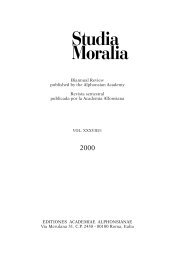Avant-propos - Studia Moralia
Avant-propos - Studia Moralia
Avant-propos - Studia Moralia
Create successful ePaper yourself
Turn your PDF publications into a flip-book with our unique Google optimized e-Paper software.
THE MORALITY OF ADOPTING FROZEN EMBRYOS 133<br />
tunately, Surtees also fails to note adequately the context of that<br />
sentence in DV and mistakenly takes it to be directed towards<br />
couples who seek a pregnancy through “artificial procreation.”<br />
However, this section is in fact directed to researchers, and the<br />
issue of the morality of artificial procreation will not be raised<br />
until the following section of DV. 33<br />
As can be seen from the quote above, Surtees believes that a<br />
couple who have commissioned the creation of more embryos<br />
than can be implanted in the uterus of the woman at the time of<br />
their creation are in a position where there is no morally acceptable<br />
solution. This is because neither of the two alternatives to<br />
their immediate implantation is, according to Surtees, morally<br />
acceptable. It is not permissible either to give them up for adoption<br />
or to cryopreserve them for future implantation.<br />
Let us first examine Surtees’s claim regarding the impermissibility<br />
of cryopreservation. He claims that the couple cannot<br />
choose to cryopreserve an excess embryo because an embryo<br />
has a right to be gestated, and freezing the spare embryo consigns<br />
it to “the ‘absurd fate’ of spending all the rest of his existence<br />
confined in deep freeze, all the while susceptible to experimentation<br />
and further inhumane treatment.” 34 However, while<br />
33 The first mention of artificial procreation comes in the opening lines<br />
of Part 2 of DV, which is entitled “Interventions upon Human Procreation.”<br />
The term “artificial procreation” is the term used by DV to refer to the<br />
combination of the fertilization of an ovum in a test-tube (i.e. in vitro) along<br />
with the transfer of the fertilized ovum (i.e. the embryo) in utero, all of which<br />
is done for the purpose of human procreation other than via the sexual<br />
union of man and woman. Surtees uses a different term – “artificial reproduction”<br />
– and while that term is ambiguous in that it could be a reference<br />
merely to artificial conception, Surtees clearly has in mind what DV calls<br />
artificial procreation, as is evident from the sentences that follow.<br />
Furthermore, Surtees also seems to overlook the descriptive thrust of<br />
DV I, 5, and is thus, like Smith, confused as to what DV means by “spare”<br />
embryos. Whereas DV is referring to those embryos which are destined<br />
never to find a human womb for a home, Surtees thinks “spare” simply<br />
refers to those embryos which are not implanted in what is typically referred<br />
to as the “first” cycle or round of IVF treatment<br />
34 Surtees (1996), 8. Note the oddity of this claim by Surtees, which he<br />
derives from DV I, 6. One could simply say that the cryopreservation will

















